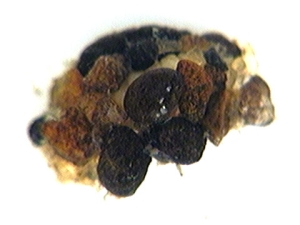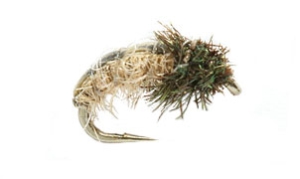 |
 |
 |
 |
 |
 |
|
"Small
but perfectly
formed": Some lesser-known westcountry river flies This page explores some of the lesser-known species of insects which can be found if you examine the stones in the rivers of Dartmoor and South Devon.  Mention caddis and most anglers assume you are
talking about
one of the numerous species of relatively large insects that form
a protective case around their bodies from small stones, sand or
pieces of vegetation. Mention caddis and most anglers assume you are
talking about
one of the numerous species of relatively large insects that form
a protective case around their bodies from small stones, sand or
pieces of vegetation.But we also have a much smaller species of caddis - Glossosoma In addition our rivers contain species of caddis that do not construct a protective case around their bodies (Rhyacophila and Hydropsyche), and - as any Summer visitor will confirm - clouds of biting midges (Simulium) which are eagerly consumed by trout as they struggle to break through the water surface. It is easy to underestimate the difficulty insects experience breaking through the barrier between water and air, and consequently how exposed they are to being picked off by hungry trout. Gary LaFontaine points out that - in human terms - it is equivalent to breaking through three feet of soil above our heads! |
 Glossosoma
caddis
Glossosoma
caddis(popular name: saddle case caddis, igloo caddis, turtle case caddis, little black short-horned caddis)
Often writers of angling books overlook small flies such as midges and small caddis in favour of the larger and more glamorous flies. As Gary LaFontaine wrote, "A sad fact of modern fly-fishing is that so much of the lore is geared to one insect, mayflies.."
The rivers running off Dartmoor are home to large numbers of the inconspicuous Glossosoma caddis which - as this picture shows - are easy to overlook especially when seen alongside a larger mayfly nymph.
Glossosoma are small (3-7 mm, hook size 18-22) caddis often present in large numbers on the algae covered upper (illuminated) surface of stones in fast flowing sections of local rivers. They are thought to be the oldest (i.e. most primitive in evolutionary terms) type of case-making caddis. The more familiar caddis which make tubular cases from sand, stones or vegetaion are thought to be a later evolutionary development.
Glossosoma larvae have to abandon their cases - rather than add extra material - when they outgrow them. At this point they may drift, or be swept, downstream which would make them susceptible to predation by trout.
Adult Glossosoma females swim underwater to deposit their eggs. This may explain the effectiveness of 'wings' on some wet flies.
- Large numbers can be present on top of rocks
- case is a small oval barnacle-like collection of small bits of stone
- glossosoma larvae cannot enlarge their case, instead they abandon their home when they have outgrown it, and drift downstream = potential trout food
- larvae and pupae have pale creamy tan bodies with dark brown heads
- adult females dive underwater to lay eggs on rocks

glossosoma - top view

glossosoma - bottom view showing head of larva on right
- imitate glossosoma pupa with a Sparkle Pupa
- imitate uncased glossosoma larva with a tan Caddis larva
- imitate egg-laying female with a Diving Caddis using wet fly swing, 'Leisenring lift', or 'induced-take techniques with weighted leader
- adults are small and grey-black in colour

Diving Caddis (Gary LaFontaine)

Sparkle Pupa (Gary LaFontaine)

Tan Caddis larva
- free-living or caseless caddis; the larvae does not construct a case
- Rhyacophilia are green colour
- relatively large - 9-15mm in size
- 'Czech nymph' method of fishing mimics behaviour and location of these insects
- Czech nymphing is a short-line deep-water technique which involves 'flicking' rather than casting a very short line upstream and allowing the flies to dead drift downstream. This process can be combined with an 'induced take' by lifting the rod.
- the heavy caseless caddis fly can be combined with a dry fly which acts as an 'indicator' when a fish takes the caddis- the 'New Zealand dropper' set-up.
 Rhyacophilia (caseless caddis) larvae |
 Hydropsyche larvae |

Hans van Klinken's caseless caddis
 Sawyer's Killer Bug
Sawyer's Killer Bug- club-shaped larvae found attached by a sucker to stones, prominent mouth 'brushes'
- pupa floats to surface in a bubble of air
- midge pupae are important trout food
- responsible for 'smutting rise'

Simulium larvae


midge pupa

Martin Joergensen's Black Funnel
Online
resources
|
 |
| anabolia nervosa: this caddis attaches bits of stick to its case |